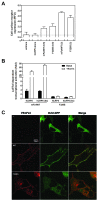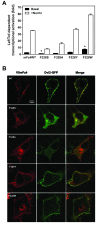The Intracellular Loop 2 F328S Frizzled-4 Mutation Implicated in Familial Exudative Vitreoretinopathy Impairs Dishevelled Recruitment
- PMID: 27096003
- PMCID: PMC4831297
- DOI: 10.5334/1750-2187-10-6
The Intracellular Loop 2 F328S Frizzled-4 Mutation Implicated in Familial Exudative Vitreoretinopathy Impairs Dishevelled Recruitment
Abstract
Familial exudative vitreoretinopathy (FEVR) is a disease state characterized by aberrant retinal angiogenesis. Norrin-induced activation of Frizzled-4 (Fz4) has a major role in regulating beta-catenin levels in the eye that, in turn, modulate the blood retina barrier (BRB). Here we gain insight on the basis of the pathology of a FEVR implicated F328S Fz4 mutant by study. The receptor exhibits a substantially reduced ability to activate Lef/Tcf-dependent transcription. This impaired activation correlates with a decreased ability to stabilize and recruit Dishevelled-2 (Dvl2) to the cell surface. Aromaticity at position 328 of the intracellular loop 2 (iloop2) is revealed similarly as a prerequisite for Dvl2 recruitment to the Fz4. This aromaticity at 328 enables normal Norrin-induced canonical activation. The corresponding position in iloop2 of other Frizzleds likely functions in Dvl recruitment.
Keywords: Dishevelled; FEVR; Frizzled; Frizzled-4; Norrin; Wnt.
Figures





Similar articles
-
Familial Exudative Vitreoretinopathy-Related Disease-Causing Genes and Norrin/β-Catenin Signal Pathway: Structure, Function, and Mutation Spectrums.J Ophthalmol. 2019 Nov 16;2019:5782536. doi: 10.1155/2019/5782536. eCollection 2019. J Ophthalmol. 2019. PMID: 31827910 Free PMC article. Review.
-
An essential role of the cysteine-rich domain of FZD4 in Norrin/Wnt signaling and familial exudative vitreoretinopathy.J Biol Chem. 2011 Mar 25;286(12):10210-5. doi: 10.1074/jbc.M110.194399. Epub 2010 Dec 22. J Biol Chem. 2011. PMID: 21177847 Free PMC article.
-
Vascular development in the retina and inner ear: control by Norrin and Frizzled-4, a high-affinity ligand-receptor pair.Cell. 2004 Mar 19;116(6):883-95. doi: 10.1016/s0092-8674(04)00216-8. Cell. 2004. PMID: 15035989
-
Frizzled-4 C-terminus Distal to KTXXXW Motif is Essential for Normal Dishevelled Recruitment and Norrin-stimulated Activation of Lef/Tcf-dependent Transcriptional Activation.J Mol Signal. 2016 Feb 5;11:1. doi: 10.5334/1750-2187-11-1. J Mol Signal. 2016. PMID: 27096005 Free PMC article.
-
Complex genetics of familial exudative vitreoretinopathy and related pediatric retinal detachments.Taiwan J Ophthalmol. 2015 Apr-Jun;5(2):56-62. doi: 10.1016/j.tjo.2015.04.002. Epub 2015 Jun 6. Taiwan J Ophthalmol. 2015. PMID: 29018668 Free PMC article. Review.
Cited by
-
Familial Exudative Vitreoretinopathy-Related Disease-Causing Genes and Norrin/β-Catenin Signal Pathway: Structure, Function, and Mutation Spectrums.J Ophthalmol. 2019 Nov 16;2019:5782536. doi: 10.1155/2019/5782536. eCollection 2019. J Ophthalmol. 2019. PMID: 31827910 Free PMC article. Review.
-
Molecular evolutionary and structural analysis of familial exudative vitreoretinopathy associated FZD4 gene.BMC Evol Biol. 2019 Mar 8;19(1):72. doi: 10.1186/s12862-019-1400-9. BMC Evol Biol. 2019. PMID: 30849938 Free PMC article.
-
Spatiotemporal dynamics of canonical Wnt signaling during embryonic eye development and posterior capsular opacification (PCO).Exp Eye Res. 2018 Oct;175:148-158. doi: 10.1016/j.exer.2018.06.020. Epub 2018 Jun 19. Exp Eye Res. 2018. PMID: 29932883 Free PMC article.
-
Functional dissection of the N-terminal extracellular domains of Frizzled 6 reveals their roles for receptor localization and Dishevelled recruitment.J Biol Chem. 2018 Nov 16;293(46):17875-17887. doi: 10.1074/jbc.RA118.004763. Epub 2018 Sep 20. J Biol Chem. 2018. PMID: 30237173 Free PMC article.
-
Dishevelled enables casein kinase 1-mediated phosphorylation of Frizzled 6 required for cell membrane localization.J Biol Chem. 2018 Nov 30;293(48):18477-18493. doi: 10.1074/jbc.RA118.004656. Epub 2018 Oct 11. J Biol Chem. 2018. PMID: 30309985 Free PMC article.
References
-
- Xu Q, Wang Y, Dabdoub A, Smallwood PM, Williams J, et al. Vascular development in the retina and inner ear: control by Norrin and Frizzled-4, a high-affinity ligand-receptor pair. Cell. 2004;116(6):883–895. doi: 10.1016/S0092-8674(04)00216-8. Avialable at: http://www.ncbi.nlm.nih.gov/pubmed/15035989 . - DOI - PubMed
-
- Kondo H, Kusaka S, Yoshinaga A, Uchio E, Tawara A, et al. Genetic variants of FZD4 and LRP5 genes in patients with advanced retinopathy of prematurity. Molecular vision. 2013;19:476–485. Available at: http://www.ncbi.nlm.nih.gov/pubmed/23441120 . PMid: 23441120; PMCid: PMC3580992. - PMC - PubMed
Grants and funding
LinkOut - more resources
Full Text Sources
Other Literature Sources

